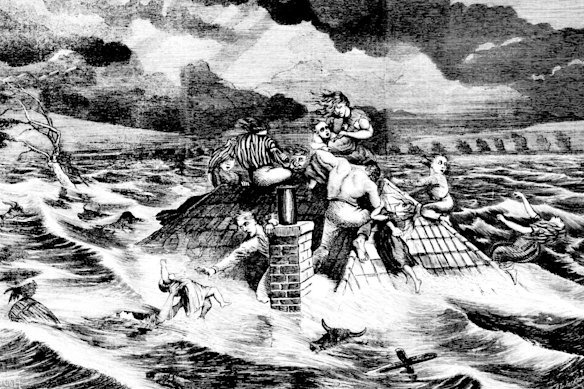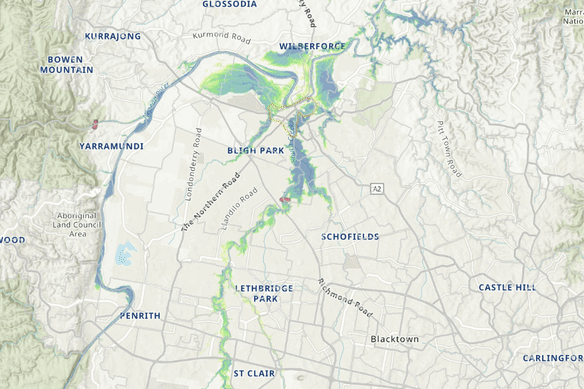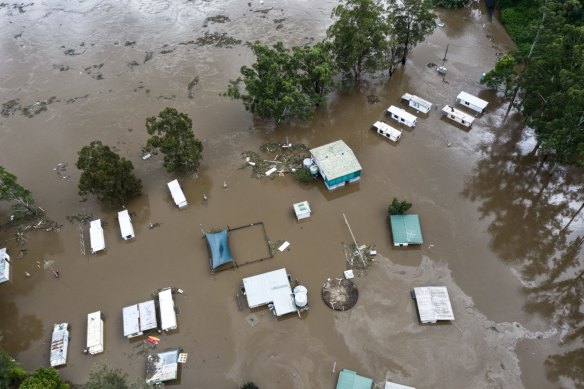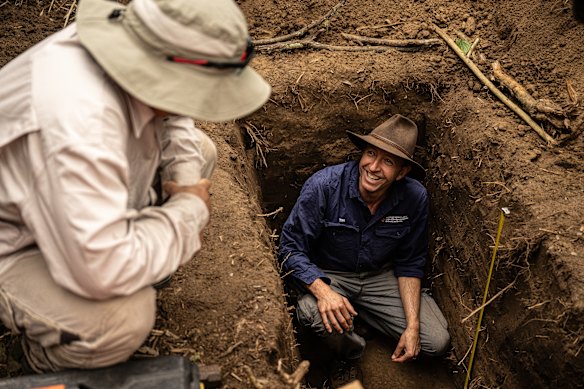A megaflood devastated early Sydney. An even worse catastrophe is hidden in the city’s ‘bathtub’
By Angus Dalton

An illustration depicting the drowning of the Eather family in the Great Hawkesbury-Nepean flood of 1867, published in the Illustrated Sydney News. Twelve members of the family died in the disaster.Credit: National Library of Australia
A thousand horses drowned. Gunshots blasted throughout the night to alert rescue boats to the locations of the stranded while floodwaters nearly 20 metres high swallowed even the homes on top of hills.
The deluge that almost engulfed the entire western Sydney suburb of Windsor summoned torrents that ripped away buildings, bedsteads, tables, chairs, the bodies of pigs, and a child seated upon a sack of flour.
The Hawkesbury-Nepean flood of 1867 killed 20 people – including 12 from the same family – and left hundreds of survivors half-naked, starving and “paralysed” with trauma, according to newspaper reports.

Graphics showing the extent of small floods (1 in 5 chance of happening every year) to the biggest flood possible (less than 0.1% chance of happening in an 80-year lifetime). Windsor is between Bligh Park and Wilberforce.Credit: NSW SES
It’s the biggest flood ever recorded in Sydney and has acted for decades as the benchmark for emergency planners for just how catastrophic a flood can be.
But there are tales of an even greater deluge. First Nations oral histories spoke of a flood so great in 1780 that even the few islands of high land in Windsor spared by the 1867 flood, which 2000 people used as refuge, went underwater.
“There was a big flood before European settlement, in which the Aboriginal peoples climbed the tallest trees, but were still swept away,” said Dr Stephen Yeo, a flood risk specialist at the NSW Reconstruction Authority.
Based on these anecdotes, Yeo believes the 1780 flood could have been two to three metres higher than the 1867 disaster, reaching 22.3 metres at Windsor.
If verified, adding the deluge to the flood record would have profound effects on what we know about disaster risk.
Based on current knowledge, for example, the 1867 flood has a one in 500 chance of happening each year. Add in the 1780 flood and that chance jumps to one in 200.

Flooding in Cumberland Reach along the Hawkesbury River in March 2022.Credit: Nick Moir
“Perhaps that 1867 flood actually can happen more frequently. And if the same happened again today, it would be much more catastrophic because there’s so much more development in western Sydney on that vast floodplain,” Yeo said.
Today a disaster on that scale would force the evacuation of 114,000 people, damage or destroy 19,000 homes, and inflict $7.5 billion in damage, according to the Reconstruction Authority. At least 2200 homes and other buildings were damaged in the 2022 Hawkesbury-Nepean flood.
Verifying the 1780 flood would also raise “one-in-100-year flood” levels expected in the Hawkesbury-Nepean, which are events that have a 1 per cent chance of happening each year. These are the flood levels used to decide the height of floors for properties built in flood-prone areas.
At Windsor, if the 1780 flood was indeed two metres higher than that of 1867, it would increase the expected one-in-100-year flood level by 1.3 metres, to 18.6 metres.
These estimates are crucial for emergency planning. The Hawkesbury-Nepean Valley is one of the highest-risk flood zones because it’s built like a “bathtub”, with five major tributaries gushing in and narrow sandstone gorge choke points that cause floodwater to back up and rise rapidly.
That’s why archaeologists and river experts have hitched a ride on State Emergency Service boats to a sandy riverbank on the Nepean, about 45 minutes up into the Blue Mountains National Park from Penrith.

Dr Daryl Lam from Water Technology takes a sediment sample using a stainless-steel tube on the banks of the Nepean.Credit: Nick Moir
Here the Reconstruction Authority is leading a “paleoflood” research project, which refers to the study of past or ancient floods, to see if it can confirm stories of the 1780 flood by analysing sediment.
Geomorphologist Tim Cohen, with an Akubra hat and a passion for dirt, is in a square-hewn hole dug into a hill about 30 metres above the river.
There are layers of dark chocolate soil and light caramel sands, with the paler layers a mark of powerful past floods that carried heavy sand high up onto land.
“Here you see a really perfect layer cake stratigraphy. So you see muds, sands, muds, sands. And the sands represent the big floods,” Cohen, an associate professor at the University of Wollongong, said.
“This could represent a flood that’s 30 metres deep,” he said, gesturing to a thick sandy stripe. “That’s an extraordinary rain event. But I guess the question is, ‘How extraordinary is it? How often does it happen?’”
To answer that question, Cohen and colleague Dr Daryl Lam from Water Technology are capitalising on an extraordinary quirk of physics: grains of sand keep a record of when they last saw sunlight.
“Every grain of sand is like a rechargeable battery,” Cohen said. “When it’s buried, it receives the radioactive decay of surrounding minerals, and that’s the charge. And what releases the charge is sunlight.”
Cohen hammers stainless-steel tubes into the sediment to collect cylinders of sand without exposing them to sunlight. Each end of the tubes is quickly covered in foil.
From here, the samples go to a red-light lab, where scientists scour the sand with corrosive baths of hydrochloric acid, hydrogen peroxide and hydrofluoric acid to remove skerricks of dirt, bugs, charcoal and tree roots. What’s left is pure quartz.
A laser is fired at each grain, which simulates the sun and triggers the release of the radioactive “charge” as a tiny flash of electrons measured by a photomultiplier.

Associate Professor Tim Cohen, from the University of Wollongong, (right) and colleague Dr Daryl Lam, from Water Technology, confer as they study past flood sediment along the Nepean.Credit: Nick Moir
Back at the dig site, Cohen measures the amount of radioactive uranium, thorium and potassium in the dirt, and the level of cosmic radiation hitting the ground from space, to establish how much “charge” the grains were receiving during their time underground.
Knowing the amount of natural radiation the grains of quartz were exposed to, and how much “charge” they released in the lab, allows the researchers to calculate how long ago the sand was buried.
“That’s what we’re after; when we date the time of deposition, that tells us about the time of the flood,” Cohen said.
Radiocarbon dating can go back 50,000 years; this method can go back a million.
A flood so big it brought sediment this high would be “nuts” but is theoretically possible, said Cohen.
As flooding turns deadlier under climate change, looking back at past disasters can help us understand when and why deadly floods may strike.
“The longer your record, the better your capacity to predict the likelihood of rare extreme events,” Cohen said.
The Examine newsletter explains and analyses science with a rigorous focus on the evidence. Sign up to get it each week.